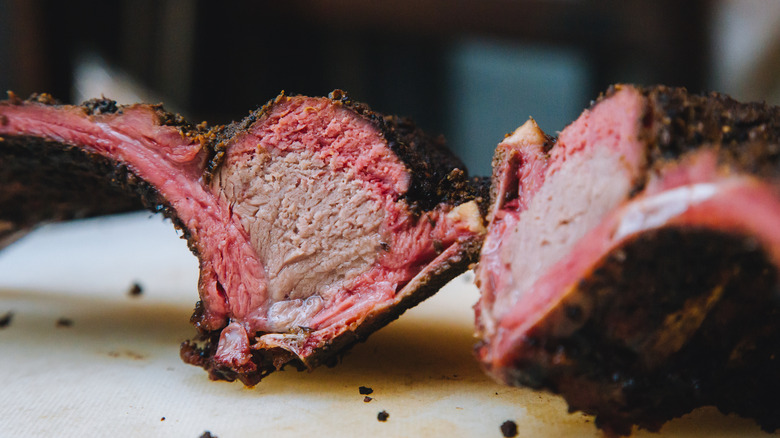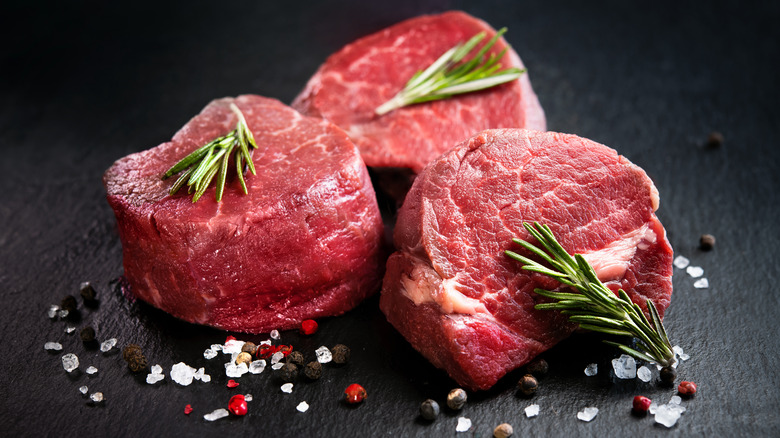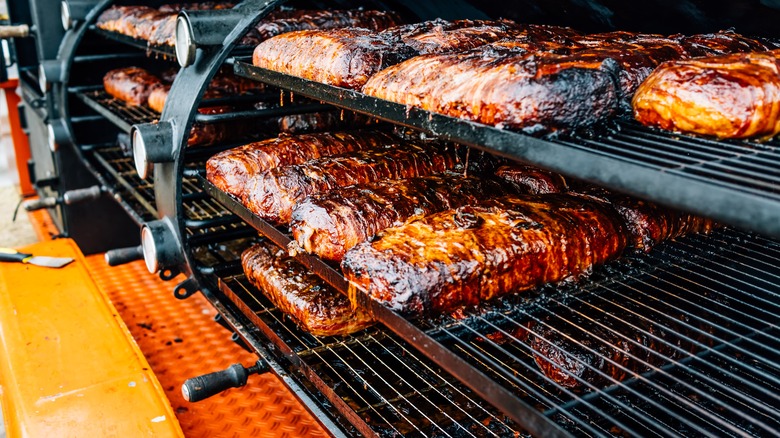The Scientific Reason Your BBQ Might Be Pink Inside
We've all done it — peered with apprehension at those pink pieces of meat served at BBQ joints or pulled from our own backyard smoker. Surely a BBQ venue must adhere to safety standards when cooking and serving the public, and you know that you tested your at-home smoked meats for the correct cooking temps and doneness levels. So what's the deal with that pink ring circling an otherwise deliciously enticing BBQ meal?
It's really more about science than neglect or misinformation on how to smoke the perfect steak, ribs, lamb, or smoked brisket masterpiece. There's a name for that pink phenomenon, according to Texas Monthly, which dubs it "the smoke ring." It doesn't mean the protein is undercooked, and it has no effect, bad or good, on the taste of the meat. If you're a BBQ connoisseur and think the ring indicates a well-executed smoking session, go ahead and throw out that myth as well. Here's why it happens.
Protein and the pink ring
The mysterious reddish-pink smoke ring on cooked meats comes down to three things, scientifically speaking — myoglobin, nitric oxide, and smoke. When you buy raw meat, it's typically red before being exposed to heat. That color comes from naturally occurring myoglobin protein in the animal, explains Texas Monthly. Once the heat from the smoker starts cooking your steak or other meat, the protein shifts to a brown color, which typically indicates that it's almost ready for consumption.
However, when wood smoke from the BBQ process gets involved, nitric oxide from the smoke can condense on the meat as it cooks and binds with the myoglobin while it's still red — producing that infamous smoke ring beneath the crusty exterior. The amount of myoglobin in particular types of meat determines how red the meat will be, which is reflected in the ring as well, notes Memphis Woodfire Grills. For example, beef contains quadruple the amount of myoglobin as pork, evidenced by the vastly redder color of beef. Oxygen exposure also affects the color, with freshly cut pieces appearing deep red and gradually turning bright red the longer they react with oxygen.
Wood matters
Wood fuels your smoker, and the type of wood you choose can affect the smoke ring. Many people, including judges at BBQ competitions, still want a pronounced ring as a sign of artful barbecuing, notes Amazing Ribs. If it's important to you when smoking at home, take a minute to consider the fuel source. Use wood bark rather than heartwood when available, since it harbors more nitrogen and consequently more potential for nitric oxide and the coveted smoke ring. Seek out recently cut green cut wood before it dries out and starts losing nitrogen.
If you're really set on having the aesthetics of a smoke ring on meats but don't have the time or equipment for smoking, there's a little cheat-sheet trick divulged by Meathead from Amazing Ribs, a BBQ Hall of Famer and New York Times bestselling author of "The Science of Great Barbecue and Grilling." You don't actually even need smoke to get the ring — you can achieve a similar effect by shaking some curing salt onto the meat before cooking in an oven. The curing salt contains sodium nitrate, which you've seen in the pink hues of hot dogs, corned beef, and processed bacon.


